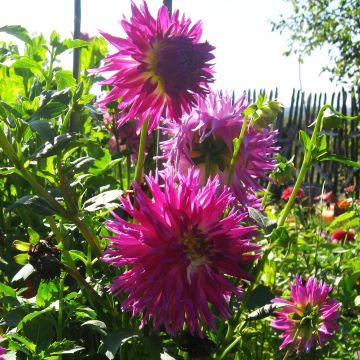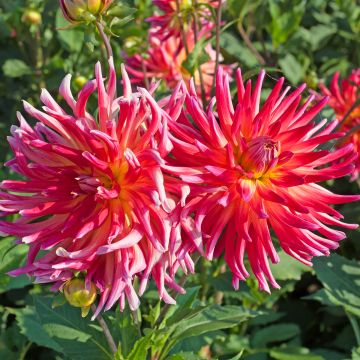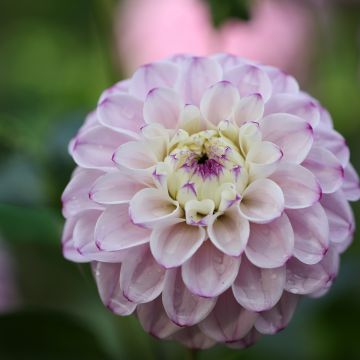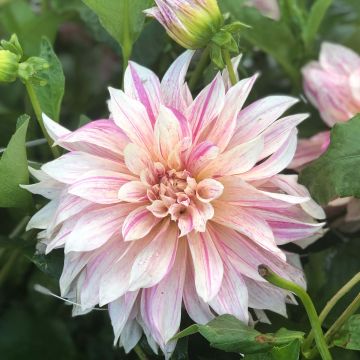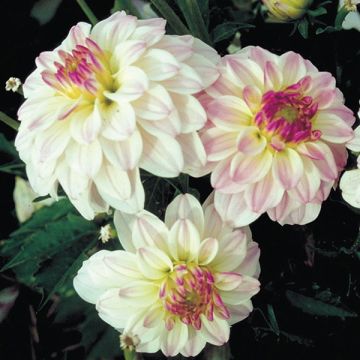

Dahlia Torsade
Dahlia Torsade
Dahlia Torsade
Unfortunately, this one turned out to be quite disappointing. Initially, it looked promising with lush spreading leaves and very sturdy stems, but Torsade blooms right at the base of the leaves, if not in the middle of them. Additionally, it opens very slowly, so that before fully blooming, it starts to wither from underneath. My specimen ended up in the compost. Perfection is not of this world. It's a shame because I love this kind of cactus with swirling petals. I'll try another one next year.
Philippe 87, 22/12/2024
This item cannot be shipped to the selected country
Delivery charge from €5.90
More information
Schedule delivery date,
and select date in basket
This plant carries a 6 months recovery warranty
More information
We guarantee the quality of our plants for a full growing cycle, and will replace at our expense any plant that fails to recover under normal climatic and planting conditions.
From €5.90 for pickup delivery and €6.90 for home delivery
Express home delivery from €8.90.
Does this plant fit my garden?
Set up your Plantfit profile →
Description
Dahlia 'Torsade' is a semi-cactus variety with unique flowers. They measure up to 17cm (7in) in diameter. The petals are purple with a darker reverse and white at the base, creating original two-tone flowers throughout summer. They make excellent cut flowers. Dahlias are easy to grow tuberous plants, in a sunny flower bed or even in the vegetable garden.
Belonging to the Asteraceae family, dahlias are tuberous plants native to the high plateaus of Mexico. Currently, there are thousands of horticultural varieties that have conquered gardens worldwide. Dahlias are classified according to the shape of their flowers. The 'Torsade' variety belongs to the Semi-Cactus Dahlias. They are characterised by colourful ligules that completely curl, giving them a pointed appearance.
This variety blooms in July and continues until the first frost. The heads measure around 17cm (7in) in diameter. Its ligules are purple and white at the base, gradually revealing a dark purple heart as they open. It has a bushy and upright habit, with hollow stems that are fragile in windy conditions. Its green leaves are opposite and divided into 3 or 5 dentate lobes.
To prolong and enhance flowering, regularly remove faded flowers. Create charming and colourful bouquets with 'Torsade' flowers. Combine complementary colours and sizes and shapes of flowers. Plant your chosen varieties in a flower bed or in the vegetable garden. Here are some suggestions: Dahlia anemone 'Dad’s Favourite' with unique flowers, the classic D. 'Snow Cap' with pure white ball-shaped flowers, or D. 'Porcelain' camellia dahlia with soft tones.
Stars of cottage gardens, cactus dahlias pair well with gauras and cleomes for a lighter look. Also consider echinaceae and salvias like S. greggii 'Amethyst Lips' with bi-coloured flowers in violet and white.
Report an error about the product description
Plant habit
Flowering
Foliage
Botanical data
Dahlia
Torsade
Asteraceae
Cultivar or hybrid
Other Cactus Dahlia
Planting and care
Dahlia 'Torsade' is easy to grow in all regions. Plant the tubers in the sun after the last frost. Rich, moist, and well-drained soil will be greatly appreciated. Avoid any stagnant moisture that promotes tuber rot. Amend your soil with compost (if the soil is poor) and with sand (for drainage), if necessary. Work your soil deeply and enrich it with crushed horn or dehydrated blood, whichever you prefer. Place your tuber and crumble the soil around it to fill any air pockets. The dahlia should be covered with about 6cm (2in) of soil. Water abundantly at planting and regularly during the first six weeks to assist with rooting.
Dahlias are sensitive to cold, so they need to be overwintered. In November, the first frosts blacken the foliage, which is the time to dig them up. Carefully remove the tubers. Remove as much soil as possible. Let the foliage dry so that the tubers can replenish their reserves. Then cut the stems to 10cm (4in). Spread your tubers in a box on newspaper. Store them in a frost-free, dry, cool, and dark place, such as a garage or attic. It is possible to leave them in the ground in warm regions, close to the coast, where there are few frosty days per year. In this case, simply cover the ground with a thick mulch (leaves, straw, etc.).
Pinch the shoots early (from the 3rd or 4th week after planting) to make your dahlia more compact and branched, and therefore more resistant to bad weather (wind, rain). To do this, cut the terminal shoots just above the previous leaves with your nails. Otherwise, you always have the option of staking, but the aesthetic result may not be the best.
Slugs and snails are very fond of these young shoots. Protect them!
Planting period
Intended location
Care
-
, onOrder confirmed
Reply from on Promesse de fleurs
Dahlias
Haven't found what you were looking for?
Hardiness is the lowest winter temperature a plant can endure without suffering serious damage or even dying. However, hardiness is affected by location (a sheltered area, such as a patio), protection (winter cover) and soil type (hardiness is improved by well-drained soil).

Photo Sharing Terms & Conditions
In order to encourage gardeners to interact and share their experiences, Promesse de fleurs offers various media enabling content to be uploaded onto its Site - in particular via the ‘Photo sharing’ module.
The User agrees to refrain from:
- Posting any content that is illegal, prejudicial, insulting, racist, inciteful to hatred, revisionist, contrary to public decency, that infringes on privacy or on the privacy rights of third parties, in particular the publicity rights of persons and goods, intellectual property rights, or the right to privacy.
- Submitting content on behalf of a third party;
- Impersonate the identity of a third party and/or publish any personal information about a third party;
In general, the User undertakes to refrain from any unethical behaviour.
All Content (in particular text, comments, files, images, photos, videos, creative works, etc.), which may be subject to property or intellectual property rights, image or other private rights, shall remain the property of the User, subject to the limited rights granted by the terms of the licence granted by Promesse de fleurs as stated below. Users are at liberty to publish or not to publish such Content on the Site, notably via the ‘Photo Sharing’ facility, and accept that this Content shall be made public and freely accessible, notably on the Internet.
Users further acknowledge, undertake to have ,and guarantee that they hold all necessary rights and permissions to publish such material on the Site, in particular with regard to the legislation in force pertaining to any privacy, property, intellectual property, image, or contractual rights, or rights of any other nature. By publishing such Content on the Site, Users acknowledge accepting full liability as publishers of the Content within the meaning of the law, and grant Promesse de fleurs, free of charge, an inclusive, worldwide licence for the said Content for the entire duration of its publication, including all reproduction, representation, up/downloading, displaying, performing, transmission, and storage rights.
Users also grant permission for their name to be linked to the Content and accept that this link may not always be made available.
By engaging in posting material, Users consent to their Content becoming automatically accessible on the Internet, in particular on other sites and/or blogs and/or web pages of the Promesse de fleurs site, including in particular social pages and the Promesse de fleurs catalogue.
Users may secure the removal of entrusted content free of charge by issuing a simple request via our contact form.
The flowering period indicated on our website applies to countries and regions located in USDA zone 8 (France, the United Kingdom, Ireland, the Netherlands, etc.)
It will vary according to where you live:
- In zones 9 to 10 (Italy, Spain, Greece, etc.), flowering will occur about 2 to 4 weeks earlier.
- In zones 6 to 7 (Germany, Poland, Slovenia, and lower mountainous regions), flowering will be delayed by 2 to 3 weeks.
- In zone 5 (Central Europe, Scandinavia), blooming will be delayed by 3 to 5 weeks.
In temperate climates, pruning of spring-flowering shrubs (forsythia, spireas, etc.) should be done just after flowering.
Pruning of summer-flowering shrubs (Indian Lilac, Perovskia, etc.) can be done in winter or spring.
In cold regions as well as with frost-sensitive plants, avoid pruning too early when severe frosts may still occur.
The planting period indicated on our website applies to countries and regions located in USDA zone 8 (France, United Kingdom, Ireland, Netherlands).
It will vary according to where you live:
- In Mediterranean zones (Marseille, Madrid, Milan, etc.), autumn and winter are the best planting periods.
- In continental zones (Strasbourg, Munich, Vienna, etc.), delay planting by 2 to 3 weeks in spring and bring it forward by 2 to 4 weeks in autumn.
- In mountainous regions (the Alps, Pyrenees, Carpathians, etc.), it is best to plant in late spring (May-June) or late summer (August-September).
The harvesting period indicated on our website applies to countries and regions in USDA zone 8 (France, England, Ireland, the Netherlands).
In colder areas (Scandinavia, Poland, Austria...) fruit and vegetable harvests are likely to be delayed by 3-4 weeks.
In warmer areas (Italy, Spain, Greece, etc.), harvesting will probably take place earlier, depending on weather conditions.
The sowing periods indicated on our website apply to countries and regions within USDA Zone 8 (France, UK, Ireland, Netherlands).
In colder areas (Scandinavia, Poland, Austria...), delay any outdoor sowing by 3-4 weeks, or sow under glass.
In warmer climes (Italy, Spain, Greece, etc.), bring outdoor sowing forward by a few weeks.



































